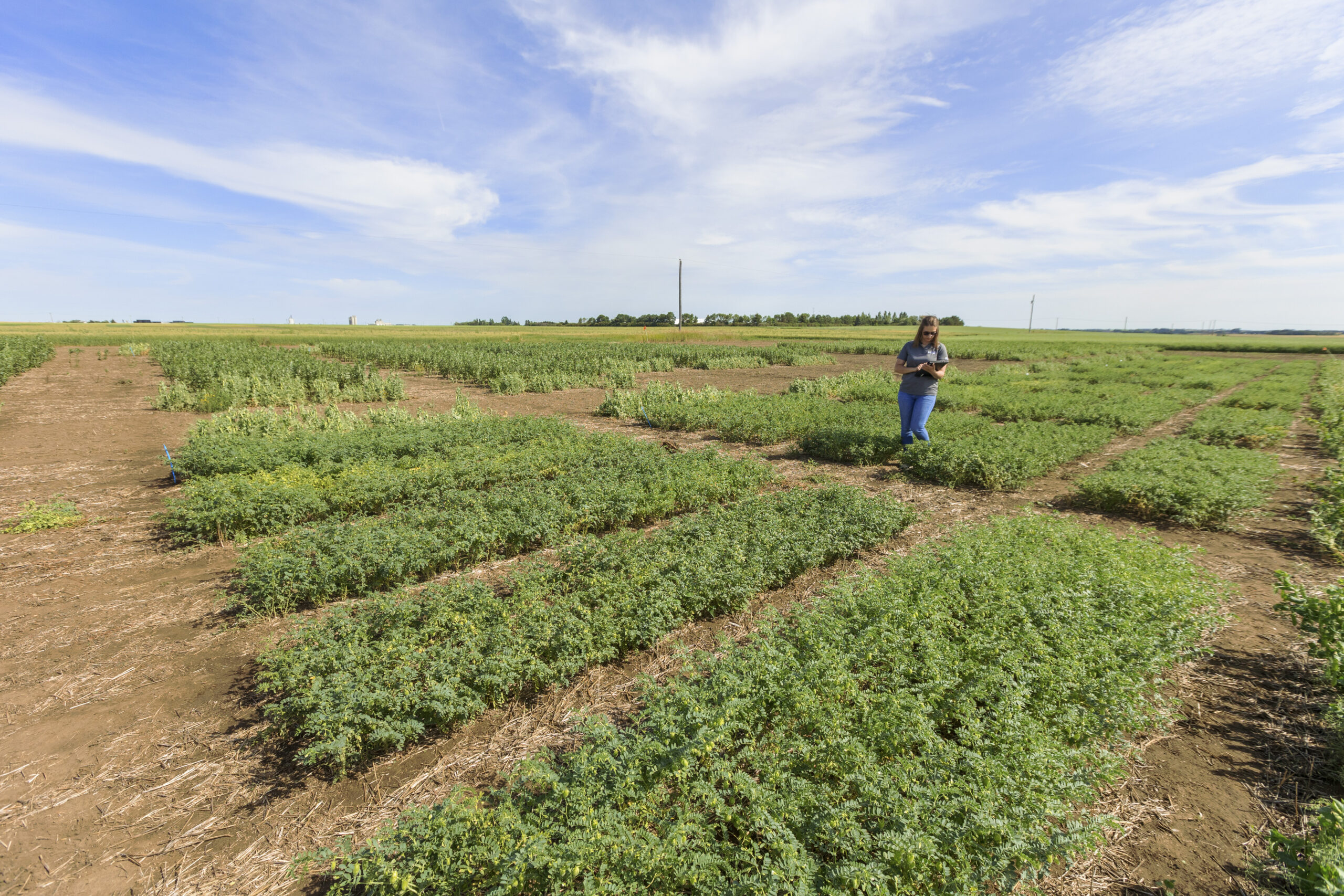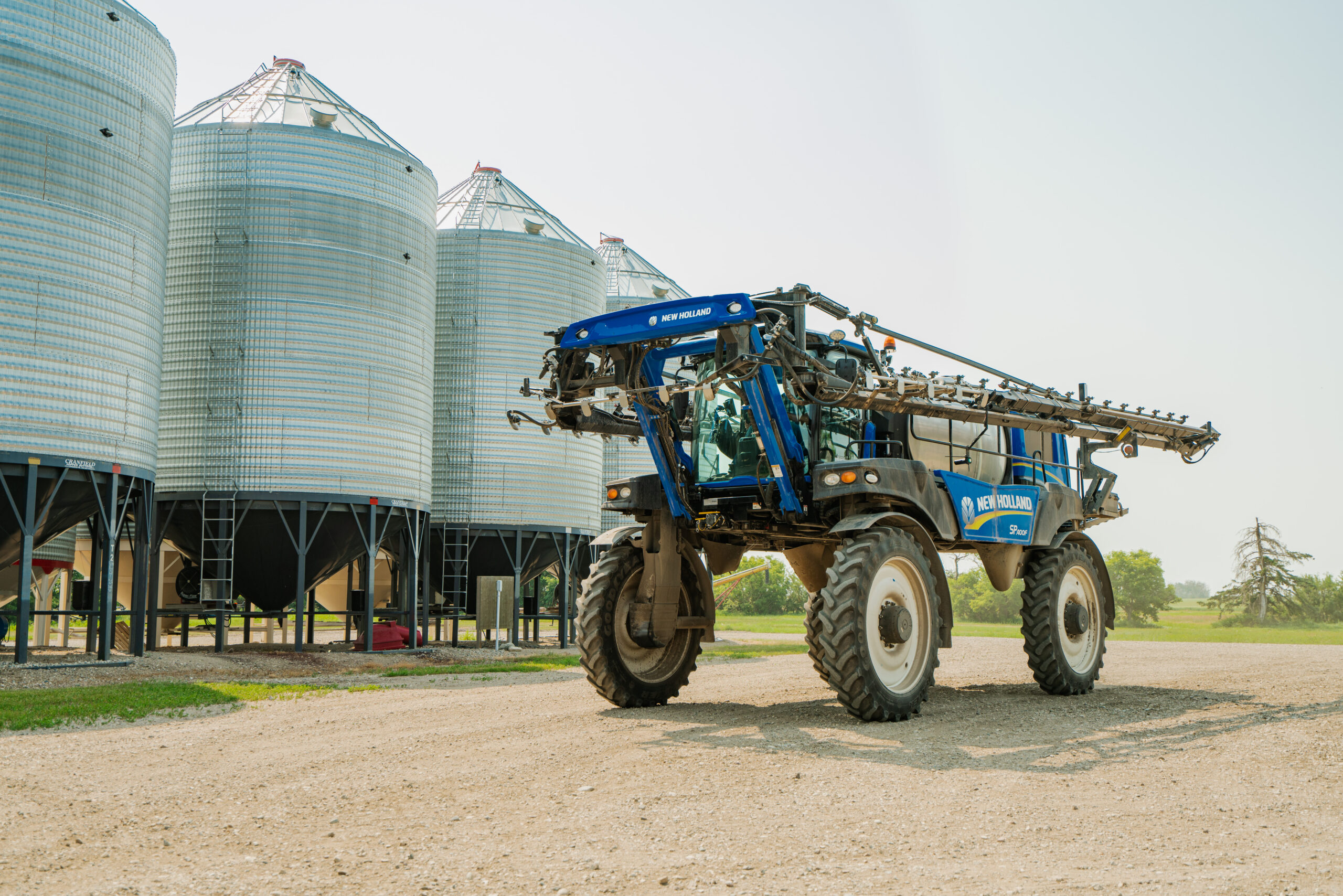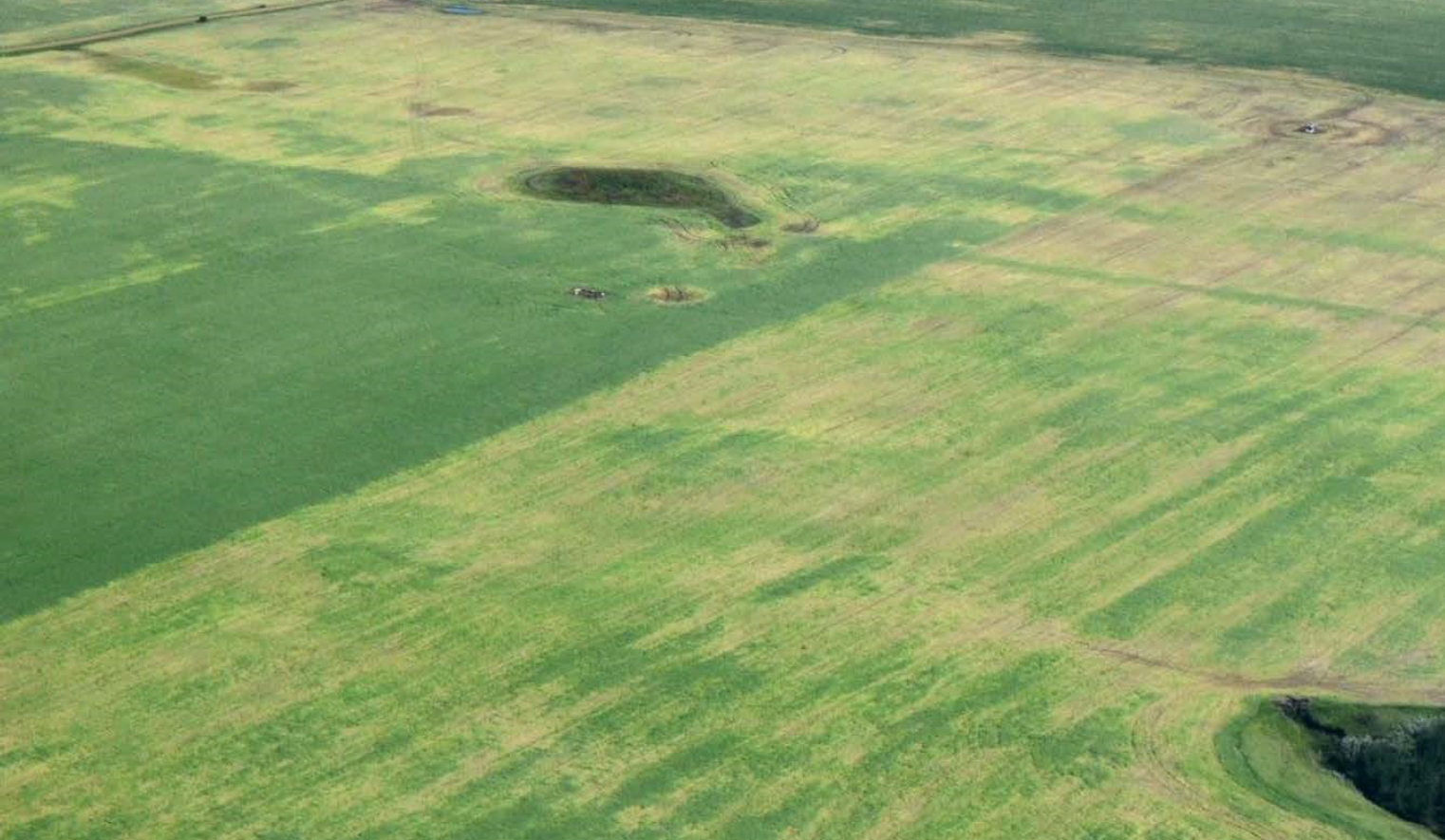Jennifer Bogdan, P.Ag., CCA
Of all the pathogens that contribute to the root rot complex in pulse crops in Saskatchewan, Fusarium species are the most predominant. Fusarium root rot causes severe root damage, preventing water and nutrient uptake by the crop, leading to premature plant death. Yield losses in pulse crops typically range from 10-30%, but can be as high as 60% in peas and 84% in dry beans, with severe infections under ideal environmental conditions. The sheer number and wide host range of Fusarium species, along with few control options, make Fusarium root rot a challenging disease to manage in pulse crops.
Host Crops
Pythium, Rhizoctonia, Aphanomyces, and/or Fusarium species can all cause root rot in pulse crops, and most other crops grown in Western Canada. As pulses are more susceptible to Fusarium species than cereals or oilseeds are, Fusarium root rot is the most common root disease in pulse crops. With over 80 different Fusarium species worldwide, Fusarium root rot is caused by a complex of Fusarium species that can differ in preference for host crops and vary in the level of aggressiveness on particular crops (Table 1).
The most common species is Fusarium avenaceum which can infect most crops, although peas and especially lentils are its preferred hosts and experience the most damage.
Table 1. Common Fusarium species found in pulse crops on the Prairies
| Fusarium Species | Features |
|---|---|
| F. avenaceum | Most common and aggressive species to cause root rot in pulses. Wide range of host plants (over 200 species), including pulses, cereals, canola, flax, and alfalfa. Very virulent on peas, lentils, and chickpeas with lentils being more susceptible than peas. Predominant root rot pathogen in wet conditions/years. Causes crown rot and is associated with Fusarium head blight in cereals. In years with high rainfall, produces moniliformin toxin to which poultry are sensitive. Also a common saprophyte (lives on dead/decaying organic matter). |
| F. solani | A species complex. Very virulent on pulses (peas, chickpeas, faba beans, and dry beans) but not on cereals or canola. Lentils are much more susceptible to F. avenaceum compared to F. solani. Drier conditions are favoured because spores can germinate in low moisture. |
| F. equiseti | Second most common Fusarium species isolated in SK, after F. avenaceum. Is a weaker root rot pathogen. Has been isolated from peas, lentils, faba beans, and flax. Has also been isolated from canola roots but does not cause disease in canola seedlings. Is a saprophyte. Although it can be associated with Fusarium head blight in cereals, it is not considered to be an important causal agent of Fusarium head blight in the prairie region. |
| F. oxysporum | A species complex causing vascular wilt in pulse crops. Is a weaker root rot pathogen producing only mild root rot symptoms. |
| F. redolens | More common on chickpeas but also found on peas, lentils, and durum (broad host range). Weaker root rot pathogen causing only mild root rot symptoms in pulses on its own. Although it can be associated with Fusarium head blight in cereals, it is not considered to be an important causal agent of Fusarium head blight in the prairie region. |
| F. virguliforme | Causes root rot and sudden death syndrome in soybeans. Has a wide host range. Canola and sugar beet may not show symptoms of infection but can still experience yield reduction. Wheat, corn, lambsquarters, and redroot pigweed do not show symptoms but can serve as hosts for the pathogen to develop and multiply. |
| F. acuminatum | Has been found to be a more prevalent species in peas and lentils. Can also cause root rot in faba beans. Is a saprophyte. Although it can be associated with Fusarium head blight in cereals, it is not considered to be an important causal agent of Fusarium head blight in the prairie region. |
| F. graminearum | Generally causes minor root rot in pulse crops but can cause severe infections on soybeans. Has been isolated from peas, lentils, faba beans, and soybeans. Most aggressive and important species causing Fusarium head blight in cereals. Produces DON vomitoxin. |
| F. culmorum | Causes minor root rot in pulse crops. Causes Fusarium head blight in cereals. Produces DON vomitoxin. |
| F. poae | Has been isolated from roots of pulse crops and can be aggressive on soybeans. Associated with Fusarium head blight in cereals. Associated with Fusarium head blight in cereals, particularly in barley and oats. Produces a large number of mycotoxins. |
| F. sporotrichioides | Has been isolated from pea and cereal roots in low amounts. Associated with Fusarium head blight in cereals. |
| F. cerealis | Typically a pathogen of cereal crops. First reported case globally of F. cerealis causing root rot in soybeans was from a field near Carman, MB in 2017. |
| F. torulosum | Has been isolated from pea roots in low amounts. |
| F. tricinctum | Has been isolated from pea and faba bean roots in low amounts. Although it can be associated with Fusarium head blight in cereals, it is not considered to be an important causal agent of Fusarium head blight in the prairie region. |
| F. cuneirostrum | Has been isolated from dry bean. Is a minor root rot pathogen. |
The Fusarium solani species complex is also very aggressive on pulses and is the most virulent Fusarium species in peas, along with F. avenaceum. Survey results from 2015 to 2018 found that F. avenaceum and/or F. solani were present in over 98% of pea and lentil fields sampled across the Prairies.
The Fusarium solani species complex is made up of over 50 genetically related pathogen species. Currently, each isolate of F. solani is divided into a forma specialis, which refers to the specific host plant originally associated to an individual isolate. For example, F. solani f. sp. pisi causes severe infections in peas and F. solani f. sp. phaseoli greatly affects beans, but these isolates may only cause mild necrosis in crops other than their primary hosts. Recent research has found F. solani f. sp. pisi to have a much greater host range beyond peas and can cause symptoms on other legumes such as faba beans, white clover, and vetches. Similarly, F. solani f. sp. phaseoli has since been shown to also infect peas and faba beans. Some scientists have suggested moving away from the ‘forma specialis’ term as it can be misleading to imply only one host plant is affected by a particular isolate.
Fusarium oxysporum is a weaker root rot species but is the pathogen responsible for causing vascular wilt in pulse crops. Like F. solani, Fusarium oxysporum occurs as a species complex with isolates divided into their formae speciales, such as F. oxysporum f. sp. pisi causing Fusarium wilt in peas, F. oxysporum f. sp. lentis causing Fusarium wilt in lentils, and F. oxysporum f. sp. ciceris causing Fusarium wilt in chickpeas. Fusarium wilt causes the entire plant to prematurely wilt and die due to the pathogen infecting the xylem (vascular tissue) and cutting off water supply to the roots and shoots. Genetic resistance is more readily available for Fusarium wilt compared to Fusarium root rot.
A weaker root rot species, Fusarium redolens, is the most common species found on chickpeas, along with F. solani, but has also been isolated from pea and lentil roots. Fusarium redolens is closely related to and looks similar to F. oxysporum so it was previously unreported or reported as Fusarium oxysporum var. redolens. It is now known to have a wide distribution across Saskatchewan and the Northern Great Plains.
Fusarium virguliforme causes root rot in a broad range of host plants (peas, beans, alfalfa, clover) but is known more for causing sudden death syndrome of soybeans. Although the infection starts early in the growing season, symptoms of sudden death syndrome appear during the reproductive phase when F. virguliforme produces a toxin that travels to the leaves, causing them to yellow and suddenly die off. While not yet a problem in Western Canada, sudden death syndrome may become more prevalent as soybean cyst nematode, which adds stress to the plant and causes a wound on the root for the pathogen to enter, becomes further established. Soybean cyst nematode has now been confirmed in multiple RMs in southern Manitoba. Fusarium virguliforme was formerly known as F. solani f. sp. glycines before it was recognized as a distinct species.
Fusarium graminearum and F. culmorum have been found at low levels on pea roots but these pathogens are more associated with Fusarium head blight in cereal crops and generally contribute little to root rot in pulse crops, with the exception of soybeans.
Life Cycle, Symptoms, and Crop Impact
The life cycles of Fusarium solani f. sp. pisi on peas and F. solani f. sp. phaseoli on dry beans have been well studied and provide a general understanding of how the pathogen infects the host plant. Thick-walled spores (chlamydospores) overwinter in infested soil and on infected crop residue or seed, and are the primary source of disease inoculum. Exudates from germinating host plant seeds signal these resting spores to germinate and produce hyphae, which infect the developing hypocotyl (region below cotyledon) and epicotyl (region above cotyledon), at the point of seed attachment. Hyphae can also produce macroconidia (asexual spores) which can directly infect developing roots. At the end of the growing season, overwintering chlamydospores are produced in infected plant tissue and the spores can survive in the soil for many years. Although not yet known, it is suspected that plant infection from chlamydospores can occur quite quickly, in about 7-10 days, similar to Aphanomyces root rot oospore infection. It is still unclear if other Fusarium pathogens, such as F. avenaceum, cause root rot in the same way as F. solani.
Fusarium avenaceum and F. poae differ from the other Fusarium species in that they do not produce chlamydospores and therefore can only survive as a saprophyte on infected crop residue. The ability of F. avenaceum to thrive in such a diversity of host environments (pulse roots, cereal roots and heads, crop residues) has allowed this pathogen to maintain or increase its prevalence in Saskatchewan.
Root rot symptoms produced are similar between most of the Fusarium species. Small brown lesions nearly always start at the point of seed attachment, where the pathogen typically first enters the plant (Figure 1). As the disease progresses, these smaller lesions coalesce into larger necrotic areas that wrap around the entire stem and can expand upwards on the stem by 1-2 centimetres above the soil level (Figures 2 and 3). Compared to Aphanomyces root rot, it takes Fusarium more time to form lesions as well as spread into the root system.
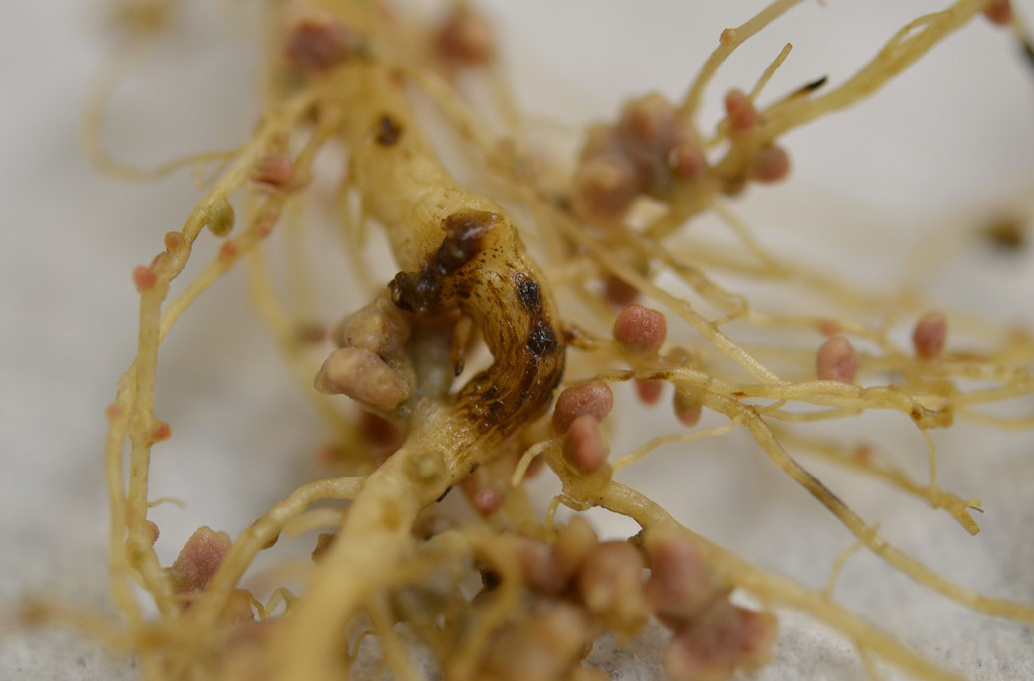
Source: Syama Chatterton, Agriculture and Agri-Food Canada

Source: Syama Chatterton, Agriculture and Agri-Food Canada
Dr. Syama Chatterton, Research Scientist with Agriculture and Agri-Food Canada, hypothesizes that the plant switching from the vegetative stage to the reproductive stage provides the stress needed for Fusarium to begin colonizing the root tissue. Severely infected root systems can experience an 80-100% reduction in root mass, along with very poor nodulation. In this final stage of root rot, the taproot is girdled and the plant is yellow, wilted, and will die off completely (Figure 4). Fusarium solani and F. avenaceum can both infect the xylem, as indicated by red streaks running through the vascular bundles (Figure 5).

Source: Syama Chatterton, Agriculture and Agri-Food Canada

the vascular bundle although it does not always occur.
Source: Saskatchewan Ministry of Agriculture
Fusarium root rot often appears as yellowing patches in the field, but shoot symptoms are indistinguishable from Aphanomyces root rot (Figure 6). Also, extensive yellowing and stand collapse do not occur to the same severity as with Aphanomyces root rot. The most severe symptoms and crop yellowing are seen when Fusarium and Aphanomyces root rots are present together (Figure 7).
Fusarium root rot impairs the uptake of water and nutrients by infected plants. Yield loss can be difficult to assess because of the numerous indirect effects on the crop, as well as the timing of the initial infection. Early season infections from seed-borne Fusarium or highly infested soil or residue cause seedling blight, and plants die prematurely causing a direct and substantial yield loss (Figure 8).

Source: Syama Chatterton, Agriculture and Agri-Food Canada
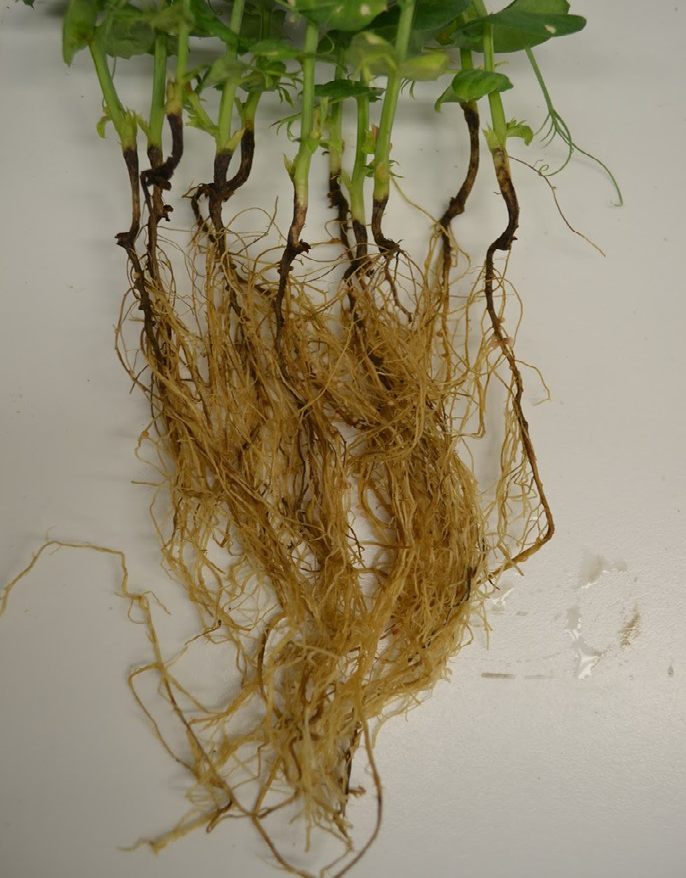
Source: Syama Chatterton, Agriculture and Agri-Food Canada

Source: Syama Chatterton, Agriculture and Agri-Food Canada
Later season infections, typically at approximately 6-8 weeks after seeding when plants are in early flower, only have a minor effect on yield but can delay crop maturity, affecting harvest timing, and also weaken the plant stems causing lodging and harvest challenges. A thin crop stand from dead plants can also cause challenges in weed management. Weed competition can negatively impact yield, affect harvestability, cause increased dockage at the elevator, and contribute to the weed seed bank in the soil.
From field surveys in Alberta, it was estimated that one-third of pea fields had symptoms of both root rot infection and pea leaf weevil feeding in 2017. A recent greenhouse study found a synergistic relationship between Fusarium avenaceum and pea leaf weevil when colonizing pea roots. Fusarium root rot severity increased when pea leaf weevil larvae were present, and more pea leaf weevil larvae successfully pupated when they fed on the root nodules of Fusarium infected plants compared to healthy plants. Field studies would be required to obtain a greater understanding of this interaction.
Favourable Conditions
Fusarium species are generally opportunistic pathogens on pulse crops and need the plants to experience some kind of stress in order for severe infections to occur. Typical environmental stressors include extreme soil moisture, high soil temperatures, flooding, and drought. High soil moisture caused from excessive rainfall, poor soil drainage, soil compaction, and/or heavy clay soils can favour Fusarium root rot development, as well as other root rot infections such as Aphanomyces. Because soil is variable across a field, patches of Fusarium root rot can develop wherever the plants have had more of a difficult time growing, such as in low spots that remain more saturated, or in compacted areas such as at field entrances, although patches may not always be obvious.
Warm soil temperatures also contribute to Fusarium root rot. For F. avenaceum in lentils, the most severe symptoms developed in soil temperatures between 20-28°C. The warm and moist conditions that typically favour a lot of Fusarium species can also favour Aphanomyces, increasing the severity of root rot in the crop.
High amounts of disease inoculum will result in higher amounts of Fusarium root rot. Fields with a history of root rot will experience more disease. Infected crop residue is especially important for the survival of F. avenaceum and is the major source of inoculum for this pathogen.
Due to the number of Fusarium pathogens present in Prairie soils, many different environmental conditions can contribute to the development of root rot. In wetter years, Fusarium avenaceum has been found to be the predominant root rot pathogen. In drier years, F. solani dominated. Some research has shown F. solani to prefer higher temperatures and F. avenaceum to favour cooler temperatures, while other studies have not found a significant correlation between Fusarium species and temperature. It is agreed that species within the Fusarium population can shift from year to year, depending on the environmental conditions experienced, therefore Fusarium root rot can occur in any kind of growing conditions, so long as there is an initial stress on the plant to facilitate the infection.
Fusarium Root Rot and Fusarium Head Blight
Of the many Fusarium species found in North America, only three are regularly found to produce Fusarium head blight in cereals: Fusarium graminearum, F. culmorum, and F. avenaceum. Fusarium graminearum is the most important and aggressive head blight species and is well established in Saskatchewan. The primary source of inoculum for F. graminearum is sexual ascospores that are blown by the wind from infested crop residue up to the cereal heads where infection takes place. For other Fusarium species that do not have air- borne ascospores, the main source of inoculum is macroconidia produced on infected crop residue. Conidia spread to the cereal heads by rain-splash when heavy rains carry the conidia upwards into the canopy, first to the leaves and eventually onto the heads.
The commonality between all Fusarium species is that infested crop residue, including that of pulses, is the main source of inoculum. However, the risk of disease transmission is much greater for a cereal crop planted on cereal or corn stubble compared to planting on pulse stubble. The cycle can also work both ways, with residue from cereal crops infected with Fusarium head blight providing a source of inoculum to facilitate Fusarium root rot in pulse crops the following year. The University of Manitoba recently confirmed the cross-pathogenicity of 9 different Fusarium species, showing that they were able to cause Fusarium head blight in wheat as well as root rot in soybeans. Fusarium graminearum and F. poae produced the most severe root rot symptoms in soybeans.
Even though many Fusarium species associated with head blight in cereals can be isolated from pulse crop roots, it does not mean that growing pulse crops will consequently increase the risk of Fusarium head blight in rotational cereal crops. Not enough information is known about the ability of pulse residue to support the adequate production of both perithecia (ascospores) and macroconidia, the sources of inoculum for Fusarium head blight, under field conditions. Although one may be able to isolate Fusarium pathogens from pulse residues, their presence may be opportunistic due to hail damage, frost, senescing plant tissues, etc. Pulse crops still remain an excellent rotational crop for reducing the risk of a range of cereal diseases, including Fusarium head blight.
Scouting and Damage Assessment
Scouting for root rots involves digging up plants and inspecting their root systems. Above-ground portions of infected plants will still appear green initially; only after the root systems become more decayed will the stems and leaves gradually turn light green then yellow. The unfortunate part of root rots is that once infection and disease development take place, there is nothing that can be done to save the crop. If Fusarium root rot is suspected, root samples can be submitted to the Crop Protection Lab in Regina where they will culture the diseased sample to determine if the pathogen is a Fusarium species or not. Since most root rot infections are caused by a complex of species, it may be unclear on which pathogen caused the root rot based on the symptoms alone. Consider testing for Aphanomyces root rot as well by submitting a soil and/or root sample for DNA testing. Fusarium species are very competitive and will outgrow Aphanomyces euteiches on an agar plate in the lab, and Fusarium symptoms will mask the honey-brown discolouration from Aphanomyces on the roots in the field. Knowing which pathogen is present can help with disease management in future crop planning. To measure Fusarium root rot severity, researchers use a 1-7 scale to rate the infection (Figure 9).

50% root mass reduction. Rating 6 shows the tap root lesion extending upwards to the crown, 100% discolouration, and 50-80% root mass loss. Rating 7 shows the tap root is completely brown/black and the plant is dead.
Source: Syama Chatterton, Agriculture and Agri-Food Canada
Management
Seed Quality and Seed Treatment
Seed testing is recommended to determine the quality of pulse seed before planting. In addition to a standard germination test, a disease fungal scan can be requested to provide helpful management information on the pending seedlot. Seed treatments are a proven option to protect against seed rot and seedling blights caused by Fusarium species as well as other pathogens such as Ascochyta, Pythium, Rhizoctonia, and/or Botrytis species. The provincial guidelines recommend using a seed treatment if seed-borne Fusarium plus Botrytis levels are 10% or higher. However, a seed treatment is not a replacement for a poor seedlot with high amounts of diseased, damaged, or dead seed. Seed treatments should also be considered when seeding in adverse conditions, such as cool and/or wet soils, or if there is a known history of seedling disease on a particular field.
There is a limit as to what can be expected from seed treatments. The fungicidal effects in the seed treatment will only last for approximately 2-3 weeks, with some of the newer products providing up to 3-4 weeks of protection. This window of protection begins at seeding, not at crop emergence. Therefore, if it takes two weeks for the crop to emerge in a cool year, the treatment may only protect the seedlings for an additional week after they have surfaced. It is best to consult the manufacturers to understand how long their products will protect the crop.
Seed treatment performance will also depend on the product rate and seed coverage. Application rate and coverage will only be as good as the equipment used to apply the seed treatment. Over-application of product can harm the seed, while under-application will not provide the minimum dose of active ingredient necessary to control the disease pathogen. It is also important to achieve uniform coverage on the seed because some active ingredients have contact properties only and must thoroughly cover the seed to ensure direct contact with the pathogen in order to control it.
There are a number of seed treatment products available with Fusarium species listed on the label. Product selection will depend on the importance of also controlling other diseases and/or insects (such as pea leaf weevil), inoculant compatibility, formulation, manufacturer, product sizes and availability, and price.
Cultural Practices
Seeding date trials have seen mixed results. In one study, lentils seeded in mid-May had a better plant establishment in Fusarium- infested soil than either early May or late May, due to the soil temperature (on average) being warm enough for quick seedling growth but still being cooler than what Fusarium prefers to proliferate in. However, warmer temperatures after seeding could favour seedling blight caused by Fusarium, even if seedling growth is also accelerated. In contrast, a trial with peas inoculated with F. avenaceum found no difference in emergence or yield when different seeding dates were used.
Because infested crop residue is the primary source of inoculum for Fusarium root rot and minimum tillage, which leaves the majority of the residue on the surface, is commonly practiced, the thought exists to go back to conventional tillage to bury the residue. Research on peas and lentils has found that the yearly environment has a greater effect on root rot development than either reduced tillage or crop rotation.
Extended crop rotations to decrease the amount of inoculum in the soil have not proven to be effective for Fusarium root rot. Peas planted in a 1-in-4 or 5-year rotation have still experienced severe root rot under the right conditions. Since F. avenaceum has such a wide host range, it can maintain or potentially increase the amount of inoculum produced in non-pulse crop years.
Weed host plants can also be infected by various Fusarium species and can serve as a source of inoculum, especially for F. avenaceum. Lambsquarters, redroot pigweed, shepherd’s-purse, chickweed, Canada thistle, field violet, alfalfa, and volunteer canola, cereals, and flax can all be infected by different Fusarium species. There are likely a number of weed species yet to be confirmed as host plants. Although the majority of the inoculum will come from the crop residue, weeds still play a small role in providing a refuge for root rot pathogens.
Biological Control
In 2008, a project out of the University of Saskatchewan (U of S) studied the potential for developing biopesticides from bacteria isolated from pulse crops in the province. Out of 563 bacteria isolates collected from pea, lentil, and chickpea roots, 40 isolates (7%) were found to suppress the growth of Fusarium avenaceum. Out of these 40 isolates, 10 isolates also suppressed Pythium and Rhizoctonia solani growth. The bacteria were collected from commercial fields with a long history of pulse crops typically grown every three years in the rotation for the past 25 years.
Genetic Resistance
Currently, there are no commercial cultivars of peas, lentils, or dry beans with complete resistance to Fusarium root rot. Host plant resistance to Fusarium root rot is quantitative, with many minor genes all working together to provide partial resistance to the plant. In pea, some quantitative genes providing partial resistance to F. avenaceum and F. solani f. sp. pisi have been identified. Similarly, some partial resistance in dry beans to F. solani f. sp. phaseoli has been reported.
The Crop Development Centre at the U of S has been screening several cultivars from the regional pea, lentil, and chickpea trials against F. avenaceum in search of finding partial resistance in the current germplasm (Appendix A). Faba bean cultivar screening is also ongoing. However, because the environment plays a large role in Fusarium root rot development, resistance expression and responses by the plant can differ in the field compared to in the greenhouse where screening initially takes place. Therefore, breeding for resistance has been a challenge and progress has been limited. Using resistant cultivars would be the most effective strategy for managing Fusarium root rot, but competitive varieties are still years away from commercialization.
Seedcoat tannins can provide some resistance to root rot pathogens. In faba beans, varieties with tannins have a dark-coloured seedcoat compared to the cream-coloured seedcoats of tannin-free varieties. Tannin-free varieties have thinner seedcoats which are more prone to cracking, providing an opportunity for fungal infection. Tannin-free varieties also lack other chemical properties that help protect the seeds from disease infection during germination. In peas, varieties with pigmented seedcoats, such as in the dun and maple pea classes, show partial resistance to Fusarium and other root rot pathogens.
Summary
- Fusarium species are the main pathogens that cause root rot in pulse crops. The seedling stage is the most susceptible to infection.
- Fusarium requires the plant to be stressed in order to first cause infection. Fusarium root rot can occur under a wide range of growing conditions, such as high soil moisture or drought, but root rot tends to be the most severe in warm, moist soil. Fields with higher levels of inoculum, mostly from infected crop residue, will experience higher amounts of root rot.
- In years with excessive soil moisture and warm soil temperatures, Fusarium root rot often occurs alongside Aphanomyces root rot, and can mask Aphanomyces symptoms. Consider submitting a soil and/or root sample to confirm which pathogen(s) are present to help with future crop planning.
- Using high quality seed and a properly applied seed treatment gives the crop its best chance during the more susceptible seedling stage. The wide host range of Fusarium species, collectively, makes crop rotation alone an ineffective strategy for Fusarium root rot management.
- Proper nutrient management can help promote the development of healthy plants and root systems to better withstand disease pressure and adverse environmental conditions. A proven nitrogen inoculant that is compatible with the seed treatment should be used at the recommended rate. Phosphorus is an energy source in the plant, supporting root formation and nitrogen fixation. Starter phosphorus is important for early plant growth, especially under the cool soil conditions associated with early seeding.
Appendix A. Results of Fusarium avenaceum greenhouse screening of pulse cultivars (2019)
Source: Sabine Banniza, Crop Development Centre, University of Saskatchewan
Table 1. Pea cultivar susceptibility to infection by F. avenaceum

Table 2. Lentil cultivar susceptibility to infection by F. avenaceum

Table 3. Chickpea cultivar susceptibility to infection by F. avenaceum


